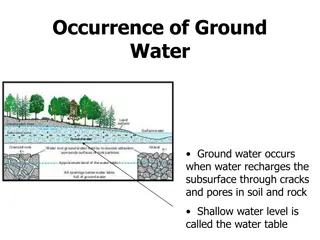Using Rainwater to Recharge Open Wells in Pathanapuram, Kollam
The project in Pathanapuram, Kollam aims to improve water availability by utilizing rainwater to recharge open wells in drought-affected areas. By diverting roof water to recharge pits near wells, the initiative has benefitted over 24075 families in the region, reducing dependency on deepening wells and saving money. House owners in the BPL category have actively participated in opening the recharge pits, contributing to sustainable water management practices.
Download Presentation

Please find below an Image/Link to download the presentation.
The content on the website is provided AS IS for your information and personal use only. It may not be sold, licensed, or shared on other websites without obtaining consent from the author. Download presentation by click this link. If you encounter any issues during the download, it is possible that the publisher has removed the file from their server.
E N D
Presentation Transcript
BEST PRACTICE UNDER IWMP BATCH-III PATHANAPURAM BLOCK, KOLLAM
STATE :KERALA DISTRICT :KOLLAM BLOCK :PATHANAPURAM PROJECT :IWMP III PIA :BLOCK PANCHAYATH PATHANAPURAM WATERSHED :KADAKKAMON
PRACTICE 40 household open wells in the draught affected locations of the watershed have been provided with devices for using roof water to recharge them
Nearly 24075 families inhabit the project area There are only 17437 open wells in the project area Most of these wells get dried up during summer (about 5-6 months)
Affected families used to deepen their wells every summer for getting water instead of augmenting ground water recharge in the localities They kept on wasting their hard earned money on thewasteful effort
METHODOLOGY case is quite simple The drainage from the rooftops is diverted by means of pipe lines to a recharge pit made near the well The methodology adopted in the
Lead line from the roof The well Recharge pit
Rain water from the roof tops has thus been used to recharge the wells. Members from benefited families have been identified as the User Groups
In most cases, the house owners themselves had opened the pit Many of them belong to BPL category
The House Owner Mr. M.B. Rameshan, Renju Bhavanam, Punnala P.O, Pathanapuram, Kollam Dist opens a recharge pit by his well
A typical recharge pit upstream the well
HOUSE OWNER: PRAMEELA SURESH AMMU NIVAS, PUNNALA(P.O) PUNNALA,PATHANAPURAM,KOLLAM(DIST) A recharge pit covered with slab
Rain water from about 4000 M2 of roof tops has been utilised by this The total quantity of rain water thus conserved amounts to about 9760 M3
IMPACT The intervention generated good impacts. All the 40 families could quite immediately avail the benefit of the summer rains The water level in the wells have recorded an average rise of 0.9 -1.4 m
So also, the local ground water stock of the area has been substantially enhanced by the percolation envisaged under the system as is evident from the enhanced availability of water from the sources downstream
TIME SPAN The activity was completed in a period of one month And the result was immediate for the lavish summer showers in the area
LEVEL The practice was taken up at the PIA level with the involvement and participation of the benefited families
RESOURCE REQUIREMENTS On an average, a sum of Rs 7,000/- has been spent per well for the purpose Beneficiary contribution has been collected from the concerned family to augment the WDF
Total expenditure involved in the activity is about Rs. 2,96,000/-
REPLICATION UPSCALING practice replicated at household level as the technology is simple and the investment is meagre. The project intents to further simplify the methodology by substituting the installation of pipe lines with simple and indigenous house yard management techniques . The can easily be
KNOWLEDGE TRANSFER The practice has become a very effective and motivating tool to disseminate the message recharge water sources to solve drinking water scarcity . The practice successful in demonstrating effectiveness and sustainability of rain water harvesting has been quite the
SUSTAINABILITY area have got roof tops suitable for harvesting the rain water for recharging wells The success of the practice will motivate the community to take up the activity in a comprehensive manner rendering it sustainable Most of the buildings in the Watershed
EXPOSURE VISITS Stakeholders from other projects shall be given opportunity to familiarize with the methodology and to advantages and impacts of it by arranging necessary exposure visits to the locality. understand the Students institutions, workers from MGNREGS etc, shall also be benefited by such visits. from various educational
Tiled roof Pipe alignments
Location of activity Between 904 50 and 905 50 North Latitude and 76053 2 and 76055 7 East Longitude



























